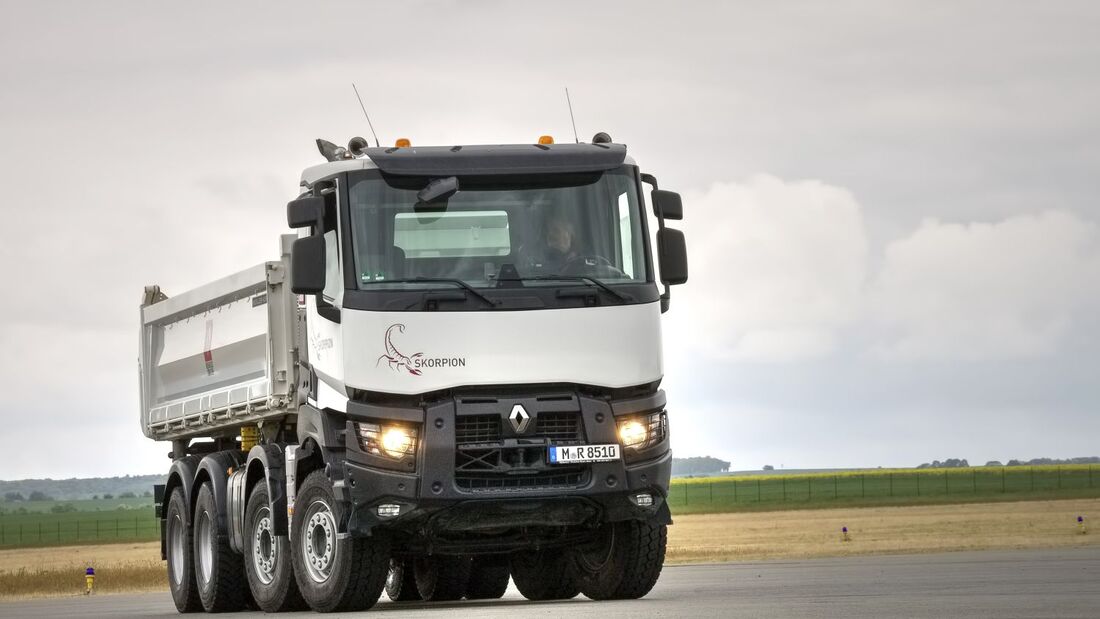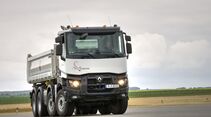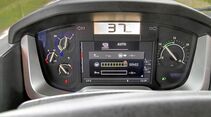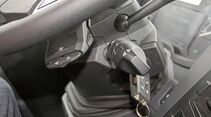Broad chest clad in armor, a poisonous insect as its heraldic animal – as the successor to the time-honored Kerax, at least the Renault K's extravagant design leaves no doubt as to its calling. The message of the heavy armor measuring up to half the total height of the driver's cab, with echoes of similar previous heavy-duty transport designs, is: This vehicle is not afraid of much.
How a car driver seeing this knight in armor fast approaching in the rear-view mirror might feel is another question. At least, both Mercedes and Renault seem in agreement that dump trucks are – today more than ever – allowed to look fearsome, something long-haul trucks have long had to resist doing for reasons of political correctness.
But there are also other considerations for this. Some manufacturers of heavy-duty trucks for the construction industry no longer want the expense of deep-mounted driver's cabs such as in the DAF CF Construction or Volvo FMX with correspondingly low entry. In which case, it is the visual appearance that must distinguish it from a heavy-duty truck.
It does not just look bad...
If, as in the case of the Renault K, the whole thing is not just an illusion, but features lots of functionalities, all the better. Crowned by the diamond-shaped company emblem, the Skorpion 8x4 front end first of all sports a sheet anchor in the form of a solid pin with a load-bearing capacity of 25 tons when hooked up. This fierce-looking grille also provides comfortable steps on two levels for whoever is bold enough to want to climb up at the front. Entry also requires some climbing. The cab floor – with 385/65 R 22.5 front-axle tires – is at a height of exactly 1,650 millimeters in three stages. Entry into the nice interior of the so-called Day Cab is via nicely arranged steps. Having taken a seat on the wide Recaro seating, which is standard in the new Renault, the Renault K reveals the same individual touch inside as outside.
Overall, the driver will find around five cubic meters of enclosed space. For a dump truck with a short cab, that is just about as big as it can get if the vehicle is to also still fit through under old silo loading points with a maximum downward clearance of 3.40 meters. The K just manages that with its total height of 3,329 millimeters. What use the high entry ultimately is, can be deduced from the engine tunnel: It juts up only about 200 millimeters, making for a light and airy atmosphere in the cab.
But a closer look gives way to a tinge of disillusionment. There is no overlooking the barrel-shaped protrusion arching in from the rear center, which instantly signals where the air filter on the Renault K is, i.e. just below. No easy task for the interior designers to solve, who then took the bull by the horns by choosing to install a spacious, almost tower-like console in the center of the cab, which has two aspects to it. On the one hand, it can safely house a lot of odds and ends and can transform into a type of mini dumb waiter if required. On the other, it unintentionally clutters the interior that was basically dimensioned so generously – thus making clambering through something for the agile.
An off-road specialist
What is more elegant is the line opposite spanning the instruments from side to side. A restrained cockpit character is the motto for the driver's workplace, offering both pros and cons. For example, it was a very nice idea the way the designers did the switches, adding a small bulge in the corner to convey the tactile sense of turning a page. In addition, they are designed for moving: The person at the wheel can relocate them to an extent, as desired. However, the way they are arranged by the factory on the right side of the cockpit hardly gives cause for intervention: Above is the cluster for air conditioning, in the center and below two double rows for all sorts of things, mostly off-road functions. The practical rotary switch for the differential locks is just a bit further to the right, but still comfortably in reach, together with two further switches with a very special function. One is provided with a truck symbol together with an undulating line under the front axle and is responsible for the rock-free mode. The other is marked "OFF ROAD" and does not refer to the automatic gearbox’s off-road mode of the same name. In fact, it is responsible for a special kind of off-road pace, which features virtually fixed revs in the style of the RQV governor.
Once it is touched, it remembers the revs and sticks firmly to them. If you want to go faster at the same revs, tapping the gear shift is enough to shift up one gear. If going slower is required, go down the gear scale accordingly. This function is useful and practical whenever the air suspension on the seat causes the driver's foot to lose contact with the gas pedal due to hilly off-road terrain.
The French manufacturer has also done some very impressive work on the off-road mode of the automatic gearbox. At one push of the button, the driver can activate ten essential functions all at once. The off-road mode is, as usual, freer in the upper rev range, always starts up in first gear, also always shifts the gears individually, and reconsiders whether to even change gear. But then there are also additional levels of finesse such as automatic attenuation of the traction control system (TCS) function, which then allows 70% slip, making it unnecessary in many cases to reach for the OFF switch. A practically automatic off-road anti-lock braking system is also included, which adapts the control phases to terrain conditions in accordance with the speed.
Unusual interior equipment with minor flaws
Of course, achieving just the right balance involves testing and learning. Overall, there is no question that there is a lot of brainpower behind it, and not just in this respect has Renault also given the new dump trucks quite a lot of its good pedigree: The electronic parking brake, for example, is another highlight showing the Renault K in a positive light. But in other respects, the new Renault K dump trucks are less impressive. Even with the instruments, for example, it is hard to recognize a clear concept. The big and clearly illustrated display right in the middle is undoubtedly beautiful – but classic round instruments on the right (tachometer) and on the left (coolant temperature, compressed air and fuel tank level) remain in disharmony in the background. And it can hardly be the best solution for the speed to be shown digitally in large figures, but the revs as usual to be indicated by a needle.
Strange conglomeration on the right side of the steering column. The conglomeration of the ignition key, the radio button, the control stalk and the massive engine brake lever does not make sense at all ergonomically, just like installing the door module on a sloping ramp under the armrest. Arranged outside of view, it forces the arm in an uncomfortable position as soon as action is required. Completely omitting the mirror heating from the door module, with the appropriate switch lurking in the air conditioning cluster, pretty much borders on a curious case of rigid adherence to principles.
And last but not least, Renault's contradictory approach to storage shelves: While there is no shortage of big and small shelves, why precisely is an anti-slip floor missing on the horizontal shelf up on the instruments? Why is the engine tunnel cover rather slippery?
Inheriting a lot of the pedigree of its Volvo parent company
Some things have not been thought through to the end; other aspects have simply been overstated. That may be because the design possibilities for Renault are limited to a very narrow space: The driver's cab, frame and automatic-gearbox software essentially bear the French manufacturer's hallmarks. The Volvo parent company's contribution is the drivetrain – from the engine through the gearbox to the axles.
And it is not a bad one either. In the case of the K 460 8x4 described here, the
10.8-liter, 460-hp engine derives its origin from the French manufacturer anyway. It was even the first truck common rail engine when it started out. After Renault became a part of the Swedish Volvo Group, unit injector elements were first adopted before returning again to the common rail system. Now with a maximum of 2,200 Nm at 1,000 to 1,400 rpm, the 460-hp version is the most powerful variant of the 10.8-liter engine.
The qualities of the I-Shift gearbox are well-known; in addition to the installed combination of AT0 2612E overdrive gearbox and 3.61 rear axle, it is important to mention: With 315/80 R 22.5 tires, it produces a theoretical top speed of 133 km/h in top gear. But the relatively low gearbox spread (15.03) speeds the first gear up to 8.8 km/h – certainly not the best choice for off-road driving, especially since these gearboxes do not possess a crawler gear. Using the standard rear axle ratio of 4.12 reduces the handicap, but does not eliminate the drawback of a missing crawler gear.
Skorpion special model
Ready-made dump trucks: Volvo has recently had good experiences with them, and
Renault is now following a similar concept. The three special models have a three-year drivetrain warranty in common, being launched under the name of "Scorpion" or "Skorpion" and adopting elements from both the Renault C and Renault K – as seen in the spelling variants. As the Renault C representative, the manufacturer offers a four-axle vehicle (8x4) with a Meiller D421 three-way tipper body (about 13 cubic meters of volume) and the equipment packages "Comfort Drive" and "Protect construction site use." In the Renault K, a 6x4 and 8x4 are optionally available. Renault provides the three-axle vehicle with the Comfort Drive 2 package and the Meiller D316 three-way tipper body (about 10.5 cubic meters of volume). The four-axle vehicle features the "Protect construction site use" package and the Meiller D421 three-way tipper body (about 13 cubic meters of volume).
Two-pronged approach on the construction site
K and C: These are the new abbreviations of what used to be called Kerax and Lander. Today, the series are divided up as follows: "Heavy construction site" is what Renault calls the Renault K area, which basically resorts to the same new cab as the heavy-duty trucks of the T family. There are short and long versions of the 2.5-meter-wide driver's cab, but not in the high roof versions. A 10.8-liter engine with 380 to 460 hp and a 12.8-liter engine with 440 to 520 hp are available. Renault offers two- and three-axle vehicles in all common configurations from 4x2 to 4x4 up to 6x4 and 6x6. Four-axle vehicles are available only with the axle configuration 8x4. The "Protect construction site use" equipment package indicates the Renault C with its driver's cab from the Premium, 2.5 as well as 2.3 meters wide. Unlike the Renault K, a 2.5-meter-wide, high roof version called the Sleeper Cab is available for the Renault C, in addition to the Day Cab and Night & Day Cab. The 2.3-meter-wide driver's cab is available in four variants from short cab to high roof version. There are no all-wheel-drive variants for the available axle configurations (two-, three- and four-axle trucks), but there is a 6x2 or 8x2 variant with trailing axle. The engines representing the 10.8-liter and 12.8-liter class mentioned above are not the only ones; there is also a 7.7-liter engine with optionally 250, 280 or 320 hp.










